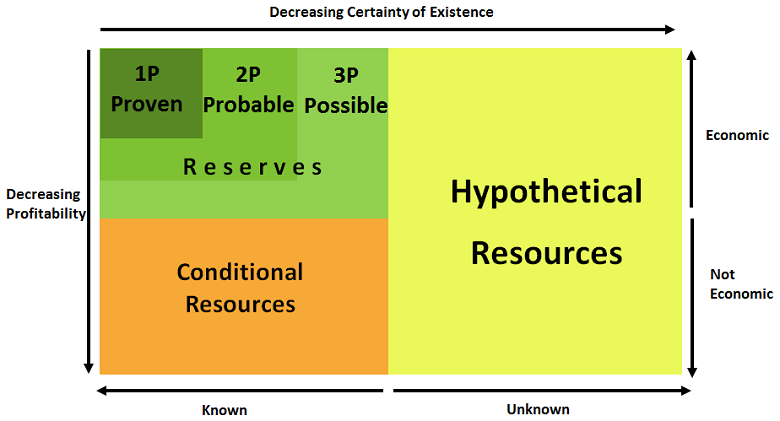McKelvey box
A McKelvey diagram or McKelvey box is a diagram that helps to explore the distinction between resources and reserves and the differences that can exist within these two broad categories. The amount of any mineral on the Earth can be explained and described in terms of their resources and reserves, thus it is important to understand what both mean in order to understand how much of this material is accessible and usable.[1]
A McKelvey diagram explores resources and reserves of different materials through the use of two distinct parameters. The first of these two parameters is the degree of certainty we have that a deposit actually exists.[1] If the deposit has been found and accessed, we know it exists to an extremely high degree of certainty. However, if the material is currently being surveyed for, the degree of certainty can be fairly low. The degree of certainty is based on information gained about the geological, physical, and chemical characteristics of a certain material and deposit including the grade or quality of the material, the amount of material in the deposit (or tonnage), and the location and depth of the material.[1]
The second parameter is the profitability of the deposit.[1] This depends on the amount of money received for this material balanced against the costs of extraction. This parameter can vary widely with upgrades in technology, shifts in world prices, and the level of competition that exists for a certain resource. Profitability decreases if the material must be transported long distances.
These two parameters can be changed by other factors such as ownership and permissions needed to access the material. They can be limited by environmental factors such as location within areas that may be environmentally significant
Position on the Diagram
In a McKelvey diagram, the two parameters explained above are used as axes or a box diagram. The large rectangle represents the entire existing quantity of the given mineral, such as coal.[2] The certainty of existence of a certain deposit decreases as you move to the right of the diagram and profitability of extracting the resource decreases as you move down the diagram.[1]
The box at the upper left of the diagram represents the reserves of a certain material. These reserves are economically feasible to recover and they are known to exist with a high degree of certainty. The bottom of this reserves box is bounded by the limit of commercial profitability.[1] Anything below this is no longer economically feasible to recover. The right hand side of the reserves box shows the limited degree of certainty of existence. Anything beyond this line hypothetically exists, but is not known to exist. A reserve must have materials that have been identified and have been deemed profitable under current conditions. This box can be split into smaller boxes using the 3 P's of reserves: proven, probable, and possible. Proven reserves have a high probability of being economically viable. Probable contains proven reserves, and has a medium probability of being economically viable. Possible reserves contain both proven and probable reserves and have a lower overall probability of being economically viable.[1]
Resources that have been identified but deemed uneconomic or unavailable are in a small box on the lower left hand side of the diagram. These resources are known as conditional resources.[1] These materials may becomes reserves if conditions change.
On the right hand side of the diagram are the hypothetical resources, which are simply resources that are known about minimally or not at all, but could end up being economic when discovered.[1]
Movement between these categories is possible - a conditional resource could become a reserve with improvements to technologies that could make the extraction economic. Conversely a reserve could become a conditional resource if more restrictions are put on the material or if the price of the material were to fall, making it less economically feasible. Successful exploration could bring hypothetical resources to either reserves or conditional resources.
Use
The McKelvey diagram is a useful way to classify resources to assess fuel availability. Although in theory the entire resource base can become reserves eventually, however that means everything that exists must be found and extracted economically. Understanding the outline of the diagram can be used to understand the risk of future coal, oil, and natural gas availability.[2]
References
- ↑ 1.0 1.1 1.2 1.3 1.4 1.5 1.6 1.7 1.8 1.9 G.Boyle, B.Everett, S.Peake, J.Ramage. (May 29, 2015). Energy Systems and Sustainability: Power for a Sustainable Future, 2nd Ed. Oxford, UK: Oxford University Press, 2012
- ↑ 2.0 2.1 Rocky Mountain Institute. (May 29, 2015). McKelvey Diagram [Online]. Available: http://www.rmi.org/RFGraph-McKelvey_diagram_for_coal_gas_resources
- ↑ Created internally by a member of the Energy Education team.


